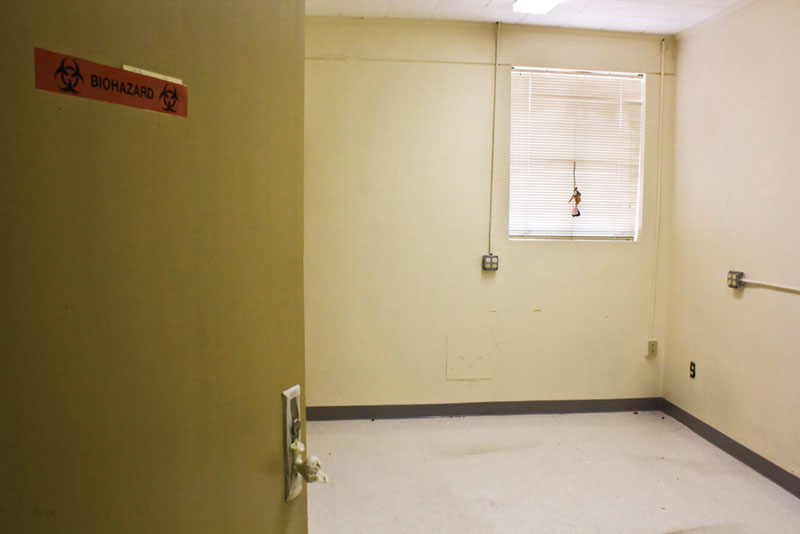
State Left Family-Planning Money Unspent While Clinics Closed
EXCLUSIVE: Texas health department had $2.3 million left over in its family-planning budget as dozens of clinics closed from lack of funds.
Above: The main room of the Hill Country Community Action Agency’s San Saba family-planning clinic now sits empty, except for a single rose hanging from the window blinds. The card on the rose reads, “Without mothers, nobody would be here!”
It turns out that Texas’ funding for family planning wasn’t so tight after all.
The Observer has learned that the state health department left unspent approximately $2.3 million in family-planning funds in the past year while scores of clinics closed due to lack of money and tens of thousands of women lost access to reproductive care.
The Texas Department of State Health Services has about $2.3 million left unspent from a federal family planning grant that totals $14.5 million, according to state records obtained through a public information request.
In an April 2013 letter submitted to the federal government, the Department of State Health Services asked the feds for permission to spend $2,328,077 left over from its 2012-2013 Title X budget. Title X (Title 10) is a key federal grant for family-planning services such as birth control, wellness exams, STD tests and other services for low-income clients. The state health department had historically received the Title X money and distributed it to family planning clinics and other providers. But in March, the federal government took the Title X grant from the health department and awarded it to a rival bidder, the nonprofit coalition of providers known as the Women’s Health and Family Planning Association of Texas.
After it lost the grant, the state health department asked the federal government, through a formal process known as a “no-cost extension” request, for permission to spend the unused $2.3 million. The money would go toward transition costs for family-planning agencies, and to shore up other providers who had lost funding when the state health department lost the Title X grant. The federal government granted the request.
Why did the state health department have so much money—about 16 percent of all its Title X money—on hand at a time when an Observer investigation found that 146 family-planning clinics lost funds, and more than 60 clinics closed as a result following budget cuts instituted by the Texas Legislature in 2011?
The Department of State Health Services claimed in documents submitted to the federal government that several large providers didn’t follow through on plans to expand services, resulting in unspent Title X money. The department also set some money aside to reimburse clinics filing their paperwork late.
Carrie Williams, a department spokesperson, defended the agency’s handling of family-planning funds and strenuously denied the state held back money at the expense of struggling clinics. “It’s standard practice for us not to spend down all the way to zero,” Williams wrote in an email to the Observer. “It’s in the best interest of providers if we leave some room for carry forward to ease a transition if funding levels change, which they obviously did, or to have cash flow going into the next year.” She emphasized that the $2.3 million is just an estimate and that providers still have time to file their spending paperwork with the state.
“Our goal has always been to get dollars to providers as quickly as possible so women can get the services they need,” Williams said.
But family-planning advocates questioned why so much money was left unspent at a time when approximately 140,000 low-income Texas women have lost services, according to researchers at the University of Texas.
“There were lots of ways that money could have been deployed,” said Clare Coleman, president and CEO of the National Family Planning and Reproductive Health Association that represents family-planning administrators nationwide. Coleman agreed that it wasn’t unusual for Title X grantees to have carry-over money. She explained that grantees often apply to the federal government for permission to spend unused funds on special initiatives, or to carry them over to the next year. But she thought that in Texas’ case, such a large sum of unspent money was excessive, especially with so many family-planning providers desperate for money to keep their doors open. “To discover that the state is sitting on so much money while the system is being decimated just underlines why it lost the [Title X grant],” she said.
Williams said the agency intends to use the remaining $2.3 million to ease the transition of the Title X grant from the state to the Women’s Health and Family Planning Association of Texas. All providers have had their contracts with the state extended to May 14.
When pressed on why the health department hadn’t spent the money earlier on providers that were struggling after funding cuts, Williams replied, “The money ultimately went to providers even after we were given notice that our funding was eliminated. Those dollars could only go to current contractors, so I’m not seeing how that can be tied to legislative reductions made last session.”
In 2011, the Legislature slashed funding for family-planning services by two-thirds. As part of the cuts, the Department of State Health Services implemented a three-level funding system that prioritized which providers would receive the suddenly meager funds. The three-tiered system removed funds, including Title X money, from many family-planning clinics, including Planned Parenthood facilities. That led many clinics to reduce services or close their doors.
In July 2012, state funding cuts caused the Bell County Public Health District to stop providing family-planning annual exams and prenatal care. Bonnie Scurzi, interim director for the Bell County Public Health District, said: “We were a top [priority] agency so we questioned all along why we didn’t get funding. Had they awarded us more money from the get-go in September 2011, then that might have meant that we could have continued providing family-planning services.”
The Bell County Public Health District had signed up for a rival Title X bid administered by the Women’s Health and Family Planning Association of Texas. When the coalition won the Title X grant, Bell County’s well-woman services were refunded. Scurzi’s team is currently re-establishing its family-planning services and expects to be operating again by the end of May. The services could have been restored sooner had the Bell County Public Health District received some of the state’s unspent Title X money.
“We’re just thankful that we’re bringing it back for the clients of Bell County because they had nowhere else to go,” Scurzi said.
But family planning clients in San Saba County and surrounding areas aren’t so lucky. Hill Country Community Action, an agency responsible for six family-planning clinics in rural Central Texas, lost $394,000 annually as a result of the health department’s funding cuts. Over a period of a few months, Tama Shaw, the agency director, closed her clinics one by one. In July 2012, Shaw admitted defeat and closed the last remaining family-planning clinic. Hill Country Community Action relinquished clinic leases, sold equipment and laid-off staff. “We couldn’t start up again. Everything is gone,” Shaw told the Observer at the time. Shaw confirmed to the Observer that her clinics in San Saba won’t be reopening, even as new funding becomes available. It’s too late. But it’s possible that if Shaw had received some of the state’s unspent Title X money last summer, she could have maintained some family-planning services that treated 2,000 low-income men and women.


